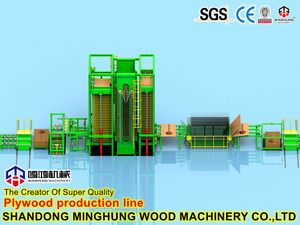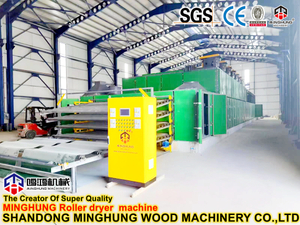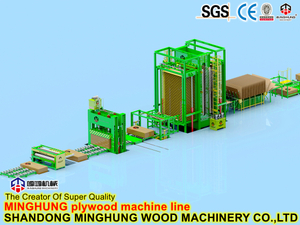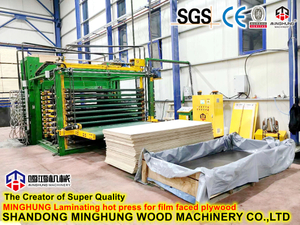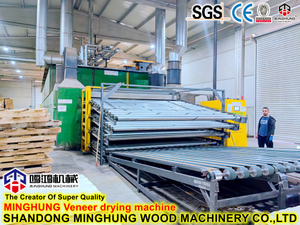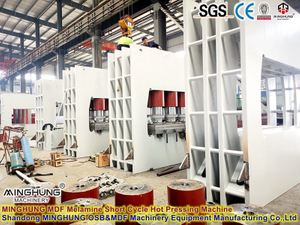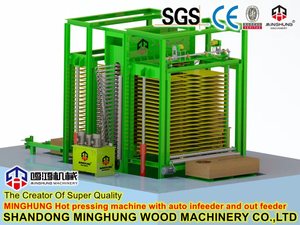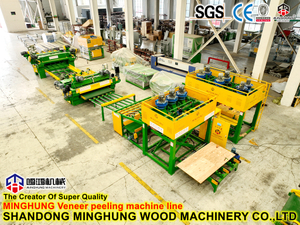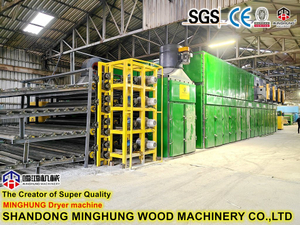Annual production of 15000m³ of plywood production line
Annual output: 15000m3/year
Product specification: 1220×2440×3mm 60%
1220×2440×11mm 40%
Tree species: poplar 40%, colored wood 20%, ash 20%, teak 20%;
Glue type: infiltrating tree adhesive;
Log specifications: Length: 6m;
Average straight line: 420mm;
Gluing method: dry heat method
Working system: 280 days/year, two shifts, 8 hours per shift;
Design requirements: determine the production process between vehicles;
Calculate the raw and auxiliary material requirements of the product;
Select production equipment and calculate the number of equipment units (sets);
Calculate the number of people required in the vehicle room;
Floor plan of workshop equipment;
SHANDONG MINGHUNG WOOD MACHINERY CO.,LTD
Calculation process and description
一、Calculate the species and percentage of each species:
Tree species: Poplar、pine、birch、Eucalyptus、Beech,ect.
Specification: 1220*2440*3mm/1220*2440*5mm
layer: 5/11layer
二、Calculate hot press production capacity:
Total pressure (t): 500/600/8001000tons; Number of hot platen layers: 20layers; Height of hot platen spacing: 70mm
Heating medium: saturated steam/heat transfer oil; Board installation direction: narrow side board; Total motor power: 29.5kw//41kw/56kw
Hot plate size: 2700×1370×42mm/2700×1370×52mm/2700*1900*52mm/1400*1400*52mm; manufacturer: MINGHUNG WOOD MACHINERY
Separate calculations of press productivity for the production of various types of plywood:
(1) Separately calculate the production rate of presses for producing various plywood, the production rate Q (m3/shift) can use the following formula Q=F×s×m×n×T×K/1000(Z1+Z2):
T-----working time per shift, 480min;
n ----- the number of working intervals of the press, n=20;
m-----The number of sheets of plywood installed in each interval (three layers m=1, eleven layers m=1)
s ------ plywood thickness (: 3mm, : 5mm)
F-----Plywood area 1220×2440=2.9768m2
Z1----pressing time in the press (three layers: Z1=3min; eleven layers: Z1=11min;)
Z2-----Auxiliary operation time takes 1.5min
K-----Working time utilization coefficient k=0.96
3mm plywood : Q1=18.10m3/shift
Poplar Q1=480×20×1×3×2.9768×0.96/[1000(3+1.5)]=18.10m3/class
pine Q1=480×20×1×3×2.9768×0.96/[1000(3+1.5)]=18.10 m3/shift
birch Q1=480×20×1×3×2.9768×0.96/[1000(3+1.5)]=18.10 m3/class
Eucalyptus Q1=480×20×1×3×2.9768×0.96/[1000(3+1.5)]=18.10 m3/shift
Beech Q1=480×20×1×3×2.9768×0.96/[1000(3+1.5)]=18.10 m3/shift
5mm plywood : Q2=23.88m3/shift
Poplar Q2=480×20×1×11×2.9768×0.96/1000 (11+1.5)=23.88m3/shift
pine Q2=480×20×1×11×2.9768×0.96/1000 (11+1.5)=23.88m3/shift
birch Q2=480×20×1×11×2.9768×0.96/1000 (11+1.5)=23.88m3/class
Eucalyptus Q2=480×20×1×11×2.9768×0.96/1000 (11+1.5)=23.88m3/shift
Beech Q2=480×20×1×11×2.9768×0.96/1000 (11+1.5)=23.88m3/shift
(2) Weighted average productivity of the hot press Qp=100/(a1/Q1+a2/Q2):
Qp: weighted average production capacity of hot press;
Q1, Q2: The output of various plywood single output of hot press;
a1, a2 The percentages specified for various plywood %, then:
Qp=100/(60/18.10+40/23.88)=20.04m3/shift
(3) Productivity of hot press machine in each shift in actual production: Q΄=15000×1.1/(280×2)=29.46 m3/shift
15000------annual output, m3;
280------Number of working days per year, days;
2------Number of working shifts per day;
1.1-----Reserved amount of doubtful project shall take 10% of annual output.
(4) Calculation of the number of hot presses n=2 η=77%
n=29.46/20.04=1.47 units, take 2 units
Load rate η=0=1.47/2×100%=77%
三. Compile the block diagram of the production process
Log Storage→ Log Cutting→ Segment Cooking→ Segment Stripping→ Segment Centering→veneer peeling →veneer drying →sorting and grading Veneer shearing→
→Gluing Veneer→Blank assembly→ cold pressing→hot pressing,→edge trimming→plywood sanding→inspection and grading→packaging and warehousing.
四. Calculation of raw material requirements
(1) Calculation of the quantity of finished products put into the warehouse QQ=QC - QC ×a/100= QC(1-a/100)
QC ----- production capacity of hot press machine shift, 29.46m3/shift;
a --------Consumption in the plywood factory takes a=4%;
Q------the quantity of finished products put into the warehouse, m3/shift;
Then Q=29.46×(1-4/100)=28.28 m3/shift
Amount of plywood consumed:
q1=QC-Q=29.46-28.28=1.18m3/shift;
Quantity of plywood consumed per m3 finished product:
q10=a/(100-a)=0.042 m3/shift.
Yield rate of finished plywood: q1=1.18 m3/shift q10=0.042 m3/shift
p1= Q / QC.×100%=28.28/29.46×100%=96.0%;
The quantity p1= QC/Q=100/(100-a)=1.042 m3/shift for every m3 of finished plywood.
(2) Quantity calculation of uncut plywood aC = (FW –FC )/FW×100% =11.2%
FW ----- Uncut plywood area m3, FW = (1.22+0.1) × (2.44+0.1);
FC------cut edge plywood area m3, FC=2.9768;
aC-------The trimming consumption percentage of the board.
Untrimmed plywood quantity calculation:
QW= FW /FC ×[100/(100-a)]×Q; that is, QW=33.19 m 3 /shift
Amount of waste from trimming: q2=Qc[(FW /FC)-1]=3.72 m3/class
Amount of scrap per m3 finished product: q2°=100/(100-a)×FW /(FC-1)=0.13m3/shift
Yield from uncut plywood to trimmed plywood: p2 =Fc/Fw×100%=88.79%
The quantity R2 of uncut plywood per m3 of finished plywood is: R2= QW /Q=Fc /Fw×(100-a)= 1.048m3
(3) Calculation of the required amount of dry veneer
The quantity of dry veneer depends on the compression rate ay calculated with the following formula: ay=(Sw-Si)/Sw×100%
Sw ----- total thickness of the uncompressed veneer in the slab: 5 layers 3.3mm; 11 layers 12.1mm;
Si------ Finished plywood thickness: 3.3mm for 5 layers; 12.1mm for 11 layers;
Then 5layers ay=(3.3-5)/3.3×100%=9.1%
11 layers ay=(12.1-11)/12.1×100%=9.1%
Calculation of dry veneer quantity: Qg=Qw×100(100-ay)
1220×2440×5
1220×2440×11
Then the total consumption is q3=4.22 m3/shift
The consumption of compression is q30 per m3 of finished plywood
q30=q3/Q=4.22/29.46=0.1432m3/shift
The yield rate from veneer to finished plywood p3=Q/Qg×100%=28.3/42.19×100%=67.08%
Quantity p3 of dry veneer consumed per m3 of finished plywood
R3=Qg/Q=1.491m3/shift
The quantity of dry veneer consumed per m3 of finished plywood should be 4% more than the above quantity:
Actual plywood consumes the number of dry veneers
p3'=1.491×(1+4%)=1.55m3/shift
(4) Calculation of wet veneer requirements
When the veneer is dried, the excess waste and a part of the veneer that will be consumed during gluing, this part of the loss ah; take ah=4%
The number of dry veneers coming out of the dryer
Qgd=100/(100-ah)×Qg
1220×2440×5 23.6m³
1220×2440×11 20.36
wet veneer requirement
Qs=Qgd×100/(100-ag)
In the formula: the drying shrinkage loss on the width of the
ag veneer is 12% for pine, 10% for poplar, 12% for beech, and 12% for birch.
Wet veneer requires total metering Qs= 46.66m3/shift
Non-recoverable loss caused by drying shrinkage:
q4=Qs-Qsg=46.66-43.96=2.7m3/shift
The yield p4 from wet veneer to finished plywood is: p4=Q/Qs×100%=29.46/46.66×100%=63.14%
Wet veneer loss per m3 of finished plywood
R4=Qs/Q=100/73.69=1.584m3/m3
(5) Calculation of log requirements
The length of the wood section required:
The length of the wood section of the backboard in the table is 2440+70=2510mm
The length of core wood section 1220+50=1270mm
(A) The effective yield rate Vd of a wood veneer is: Vd=L/104 (k1×dm2-k2×dm-0.75ds2)
In the formula: Vd ------ the number of wet veneers that can be obtained by rotary cutting a piece of wood
dm -----The average diameter of the wood section is 260cm
L ------- wooden section length 6m
ds ------ wood core diameter 5.5cm k1, k2 coefficient:
For example, a piece of plywood has the following types of wood:
Poplar k1 =0.75, k2 =1.2 Ash k1 =0.73, k2 =1.25
Color wood k1 =0.73, k2 =1.25 Basswood k1 =0.73, k2 =1.25
When the length of wood section is 2510mm,
Poplar Vd1=2.51/106 (0.75×4202-1.2×420-0.75×552)=0.325m3
Ash Vd2=2.51/106 (0.73×2602-1.25×260-0.75×552)=0.316m3
Color wood Vd2=2.51/106 (0.73×2602-1.25×260-0.75×552)=0.316m3
Basswood Vd2=2.51/106 (0.73×2602-1.25×260-0.75×552)=0.316m3
When the length of wood section is 1270mm
Poplar: Vd3=1.27/106 (0.75×4202-1.2×420-0.75×552)=0.164m3
Ash Vd4=1.27/106 (0.73×2602-1.25×260-0.75×552)=0.160m3
Color wood Vd4=1.27/106 (0.73×2602-1.25×260-0.75×552)=0.160m3
Basswood Vd4=1.27/106 (0.73×2602-1.25×260-0.75×552)=0.160m3
(B)Fragment material produced when wood segments are rounded: Vb=Vm-Vs-Vd
In the formula: Vs--wood core volume; Vm--wood section volume; Vd--effective yield rate of a wood section;
For example, when a piece of plywood has the following wood combinations:
When L=2.51m, Poplar: Vb1= 0.348-0.00596-0.325=0.01679m3
Ash: Vb2= 0.348-0.00596-0.316=0.02579 m3
Color wood: Vb2= 0.348-0.00596-0.316=0.02579 m3
Basswood: Vb2= 0.348-0.00596-0.316=0.02579 m3
When L=1.27m Poplar: Vb3= 0.176-0.00596-0.164=0.00599m3
Ash: Vb4= 0.176-0.00596-0.160=0.00999 m3
Color wood: Vb4= 0.176-0.00596-0.160=0.00999m3
Basswood: Vb4= 0.176-0.00596-0.160=0.00999 m3
(C)The veneer output volume V of a piece of wood: V=Vd+Vb×100×N
For example, when a piece of plywood is composed of the following types of wood
When L=2.51m, Poplar: V1=0.325+0.01679×0.2=0.328358m3
Ash: V2= 0.316+0.02579×0.2=0.32116m3
Color wood: V2= 0.316+0.02579×0.2=0.32116m3
Basswood: V2= 0.316+0.02579×0.2=0.32116m3
When L=1.27m, Poplar: V3= 0.164+0.00599×0.2=0.165198m3
Ash: V4= 0.160+0.00999×0.2=0.162m3
Color wood: V4= 0.160+0.00999×0.2=0.162m3
Basswood: V4= 0.160+0.00999×0.2=0.162m3
Total V=1.943m3
(D)Timber Requirements
Number of wood segments Nm=Qs/V
In the formula: Qs---the required wet veneer volume m3; V------the output rate of a wood section
For example, when a plywood is composed of the following logs:
1220×2440×5 Ash: L=2.51m, Nm1=(3.94×2/3)/0.32116=9 roots
Color wood: L=2.51 meters, Nm1=(3.94×2/3)/0.32116=9 pieces
Basswood: When L=2.51m, Nm1=(3.94×2/3)/0.32116=9 pieces
Poplar: When L=2.51 meters, Nm2=(14.66×2/3)/0.328358=30
Fraxinus mandshurica: when L=1.27 meters, Nm1'=(3.94×1/3)/0.162=9 roots
Color wood: L=1.27 meters, Nm1=(3.94×1/3)/0.162=9 pieces
Basswood: When L=1.27m, Nm1=(3.94×1/3)/0.162=9 pieces
Poplar: When L=1.27m, Nm2'=(14.66×1/3)/0.165198=30
1220×2440×11
Ash: L=2.51m, Nm3=(3.94×6/11)/0.32116=7 roots
Color wood: L=2.51 meters, Nm3=(3.94×6/11)/0.32116=7 pieces
Basswood: When L=2.51m, Nm3=(3.94×6/11)/0.32116=7 pieces
Poplar: When L=2.51 meters, Nm4=(14.66×7/11)/0.328358=29
Fraxinus mandshurica: when L=1.27 meters, Nm3'=(3.94×6/11)/0.162=14 roots
Color wood: when L=1.27 meters, Nm3'=(3.94×6/11)/0.162=14 pieces
Basswood: When L=1.27m, Nm3'=(3.94×6/11)/0.162=14 pieces
Poplar: When L=1.27m, Nm4'=(14.66×7/11)/0.165198=57
(E)For example, when a piece of plywood is combined with the following types of wood Then the total log length is required:
When L=2.51m,
Fraxinus mandshurica: 9+7=16 roots
Color wood: 9+7=16
Basswood: 9+7=16
Poplar: 30+29=59 roots
When L=1.27m,
Ash: 9+14=23 roots
Color wood: 9+14=23
Basswood: 9+14=23
Poplar: 30+57=87 roots
(F)For example, when using the following wood combinations for a check:
Timber volume Qm: When L=2.51m,
Ash: Qm1=16×0.348=5.568m3
Color wood: Qm1=16×0.348=5.568m3
Basswood: Qm1=16×0.348=5.568m3
Poplar: Qm2=59×0.348=20.532m3
When L=1.27m,
Ash: Qm3=23×0.176=4.048m3
Color wood: Qm3=23×0.176=4.048m3
Basswood: Qm3=23×0.176=4.048m3,
Poplar: Qm4=87×.0.176=15.312m3
Total Qm=64.692m3
For example, when plywood uses the following wood combinations: The amount of waste q5 generated during rotary cutting of wood segments is:
When L=2.51m, Ash: q5=(0.348-0.32116)×16=0.43m3
Color wood: q5=(0.348-0.32116)×16=0.43m3
Basswood: q5=(0.348-0.32116)×16=0.43m3
Poplar: q5=(0.348-0.328358)×59=1.16m3
When L=1.27m, Ash: q5=(0.176-0.162)×23=0.32m3
Color wood: q5=(0.176-0.162)×23=0.32m3
Basswood: q5=(0.176-0.162)×23=0.32m3
Poplar: q5=(0.176-0.165198)×87=0.94m3
The total amount of waste q5 total = 4.35 m3
The amount of waste per m3 of finished plywood q50=q5/Q=0.148m3/m3
For example a piece of plywood when using the following wood combinations:
The amount of waste p5 from wood section to wet veneer is: p5=V/Vm×100%
When L=2.51m, Ash: p51=0.1125/0.1348×100%=83.46%
Poplar: p52=0.1109/0.1348×100%=82.27%
Ash: p51=0.1109/0.1348×100%=83.46%
Poplar: p52=0.1109/0.1348×100%=82.27%
When L=1.27m, Ash: p53=0.0584/0.070×100%=83.43%
Poplar: p54=0.0576/0.070×100%=82.29%
Poplar: p54=0.0576/0.070×100%=82.29%
Poplar: p54=0.0576/0.070×100%=82.29%
Then the yield p5' from the wood section to the wet veneer is: p5'=Q/Qm×100%=28.3/64.692×100%=43.74%
The wood section consumption p5 per m3 of plywood is: p5=100/p5'=100/45.54=2.29m3/m3
For example, when a piece of plywood uses the following wood combinations: determine the required quantity of logs Qy
Qy=100Qm/(100-ar) In the formula: ar is considering the loss of the flute field (log truncation rate): Determine ar=2%---4%, take ar= 4%
Q y=100×64.692/(100-4)=67.39 m3
The yield p6 from log to wood section is: p6=Q m/Q y×100%=64.692/67.39×100%=96%;
The log requirement R6 per m³ of finished plywood is: R6= Q y total / Q=67.39/28.3=2.38m³/ m³;
The output rate p61 from log to finished plywood is: p61= Q / Q y total × 100% = 41.99%;
(G)
Determine the quantity Qy of logs required
Qy=100Qm/(100-ar) In the formula: ar is considering the loss of the flute field (log truncation rate):Determine ar=2%---4%, take ar= 4%
Q y=100×64.692/(100-4)=67.39 m3
The yield p6 from log to wood section is: p6=Q m/Q y×100%=64.692/67.39×100%=96%;
The log requirement R6 per m³ of finished plywood is: R6= Q y total / Q=67.39/28.3=2.38m³/ m³;
The output rate p61 from log to finished plywood is: p61= Q / Q y total × 100% = 41.99%;
(H)When plywood uses the following wood combinations: Unutilized wood core volume:
When L=2.51 m,
Ash: V1=3.14×0.0552/4×2.51×16=0.095m³/shift;
Color wood: V1=3.14×0.0552/4×2.51×16=0.095m³/class;
Basswood: V1=3.14×0.0552/4×2.51×16=0.095m³/class;
Poplar: V2=3.14×0.0552/4×2.51×59=0.352m³/class;
When L=1.27m,
Ash: V3=3.14×0.0552/4×1.27×23=0.069m³/shift;
Poplar: V4=3.14×0.0552/4×1.27×87=0.263 m³/class;
Ash: V3=3.14×0.0552/4×1.27×23=0.069m³/shift;
Poplar: V4=3.14×0.0552/4×1.27×87=0.263 m³/class
V=0.352+0.095×3+0.263+0.06923=1.107m³/shift;
(I)
Unutilized chipped material volume when plywood uses the following wood combinations:
When L=2.51 m,
Ash: V1=0.02579×0.8×16=0.3301 m³/class;
Color wood: V1=0.02579×0.8×16=0.3301 m³/class;
Basswood: V1=0.02579×0.8×16=0.3301 m³/class;
Poplar: V2=0.01679×0.8×59=0.7925m³/class
When L=1.27m,
Ash: V3=0.00999×0.8×23=0.1838 m³/class;
Color wood: V3=0.00999×0.8×23=0.1838 m³/class;
Basswood: V3=0.00999×0.8×23=0.1838 m³/class;
Poplar: V4=0.00599×0.8×87=0.4169 m³/class;
Total unutilized crushed material volume: V=0.7925+0.3301×3+0.4169+0.1838×3=2.7511m³/shift;
五. Calculate the amount of glue used:
1. The amount of rubber required per m³ of finished product Qgj
Qgj=[q(m-1)/Sj×Kj
q-----process consumption quota (take 300g/ m³ adhesive layer);
m----the number of plywood layers (m=3 and m=11);
Sj-------plywood thickness (Sj=3mm and Sj=11mm);
Kj------plywood processing coefficient;
Kj=Fw/Fj>1
Fw----unprocessed plywood area (Fw=1.27×2.51);
Fj------processed plywood area (Fj= 1.22×2.44);
Then Kj=3.1877/2.9768=1.07>1
The amount of glue required per m³ of finished three-layer plywood: Qgj=[300×(3-1)]/3×1.07=321 kg/m³;
The amount of rubber required per m³ of eleven-layer plywood finished products Qgj=[300×(11-1)]/11×1.07=291.8 kg/m³;
In the rubber consumption quota Q0, various production consumption should also be considered, then Q0= Qgj×f; In the formula: f takes 1.02;
Then the amount of rubber required for each m³ three-layer plywood finished product: Q0=321×1.02=327.42 kg/m³;
The amount of rubber required for each m³ of eleven-layer plywood finished products: Q0=291.8×1.02=297.65 kg/m³;
2. Calculation of annual glue requirement per shift:
Q class = Q'×Q0×η; where: Q'------productivity per shift, m³/shift;
η------Percentage of plywood;
5 plywood
Class Q=29.46×327. 42×60%=5787.48kg;
11 plywood
Class Q=29.46×297.65×40%=3507.51kg;
Year Q=C×t×Q class; in the formula: C-----the number of working shifts, take C=2;
t------Number of working shifts per year t=280;
5-ply plywood
Year Q=2×280×5787.48=3240.989 t
11 ply plywood
Year Q=2×280×3507.51=1964.204 t
Total demand Q= 5205.193 t
六. Main equipment requirements:
1. Veneer Manufacturing Equipment Calculation
(A). Cut sawing yield Q=60K×T×q/(t1+t2)×z
In the formula: t1------the time spent on each kerf, take 1.56s
t2------From one saw cut to the next saw cut, the log moving time, take 50s
z-------the sawing number of a log
K------Utilization coefficient of working hours per shift, take 0.7
T-------450min working time per shift
q-------a log volume m³
Choose KP---4 type circular saw machine
Q=60×0.7×450×0.83/40/4=98m³/class
Number of units: n=Q1/Q=64.692/98=0.6601 units, take 1 unit;
Load: η=0.6601/1=66.01%;
Saw body length: 1750mm:; the maximum diameter of sawing wood section: 1400mm;
Saw road width: 7mm; Motor power: 5.5kw
(B). Log debarker+Veneer peeling machine:

4feet wood debarker
Model: MH-WD4A
Max log length: 1400mm
Max log diameter: 550mm
Speed: 70m/min
Electric parts: Schneider
Roll type: electroplate(wear-resisting)
Total power: 29.5kw
Single roll motor:11kw
Double roll motor: 11kw
Hydraulic station: 7.5kw
Knife size: 1500*180*16mm
Weight: 4ton
Size: 3800*2300*1500mm
4feet veneer peeling machine Model: MH-VPM4A Max log length: 1400mm Max log diameter: 500mm Thickness: 0.5-4mm Speed: 60m/min Total power: 46.5kw Single roll motor:7.5kw*2pcs Double roll motor: 7.5kw*2pcs Feeding motor: 11kw(servo motor) Cutter motor: 4kw Rubber roll motor: 1.5kw Electric box: with air-conditioner for inside parts. Weight: 7ton Peeling knife size: 1500*180*16mm Cutting knife size: 1500*90*12.7mm Machine size: 4300*2300*1500mm
Promise: make sure the thickness accurate. |
(C)Equipment selection and calculation of veneer dryer and veneer drying :
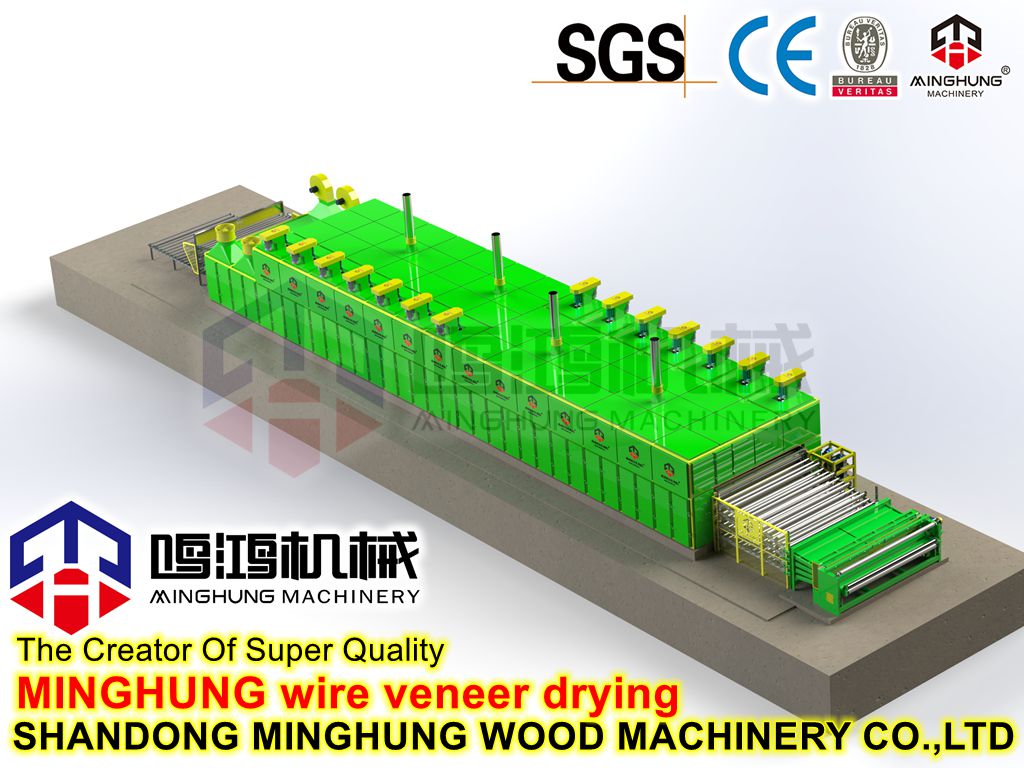
Productivity Q of mesh belt dryer (m³/shift)
Q=(T×n×m×s×b×L×K1× K2× K3)/(1000×z)
In the formula: T ----- working time per shift (s);
n-----Number of veneer sheets on the width of each layer, take n=3;
m----the number of layers, take m=5;
s------Veneer thickness 1.1mm;
b------Single board width 1.27m;
L------The working length of the dryer is 19m;
K1----take 0.95;
K2----take 0.98;
K3-----maneuvering time utilization coefficient, take 0.98;
Q=(450×3×5×1.1×1.27×19×0.95×0.98×0.98)/(1000×5.43)
=33.6m³/class
Choose MINGHUNG wood machinery factory MH-3840 mesh belt type veneer dryer, the technical parameters are as follows:
Machine layers 2 floors
Hot air system Heating area 15 sections x 2m = 26m
Cold air system Cold area 3 sections section×2m=6m
Feeding length Infeeding roller 4.5m
Infeed conveyor roller 2.67m
Outfeeding flat conveyor length Outfeeding flat conveyor 2.77m
Radiator 13pcs
Radiator size Radiator size 1850*870*35mm
Total power Total power 137.4KW (WANNAN motor)
Conveyor motor 5.5kw×1pcs=5.5kw
Heating blower motor 7.5kw×15pcs=112.5kw
Cooling fan motor 7.5kw*2pcs=15kw
Moisture removal motor 2.2kw*2pcs=4.4kw
Transmission motor The transmission speed 1-17m/min
Heating method Heating medium heat transfer oil or steam Oil /Steam
Drying temperature Drying temperature 120-170℃
Dry veneer thickness Veneer thickness 1.7-2.2mm
Initial moisture -60%
The end moisture %0-%10±1
Output Drying capacity 3-4m3/hour
External dimensionsMachine size 45.94*5.6*4.7m(L*W*H)
WeightWeight(about) 102ton
(D) Calculations for plywood manufacturing equipment:
1. Calculation and selection of gluing machine equipment:
The number of glue applicators is calculated by the following formula:
n=l×m/(t×π×d×n×K)
In the formula, l------the length of a middle plate (m);
m-------The number of middle plates that all presses need to glue in one pressing cycle (three layers
15 sheets, 55 sheets on the eleventh floor);
t-------one working cycle time of the press (7 minutes for the third floor, 30 minutes for the eleventh floor)
d-------diameter of gluing roller (m);
n-------gluing roller speed (r/min);
K------Glue utilization coefficient, take K=0.70;
Coating roller diameter: 300mm; blank size: maximum width: 2600mm
Coating roller line speed: 0.6m/s; Dimensions: 2800×1000mm;
Because 2π×r×n=v=35, so r=19.12r/min
Then the three-layer plywood n1=(2.51×15)/(7×3.14×19.12×0.3×0.7)=0.4266 units
Then eleven layers of plywood n2=(2.51×30)/(13×3.14×19.12×0.3×0.7)=0.4595 units
A total of n=0.886 units, take 1 unit,
Load percentage η=0.886/2×100%=88.6%
2700mm Glue machine:
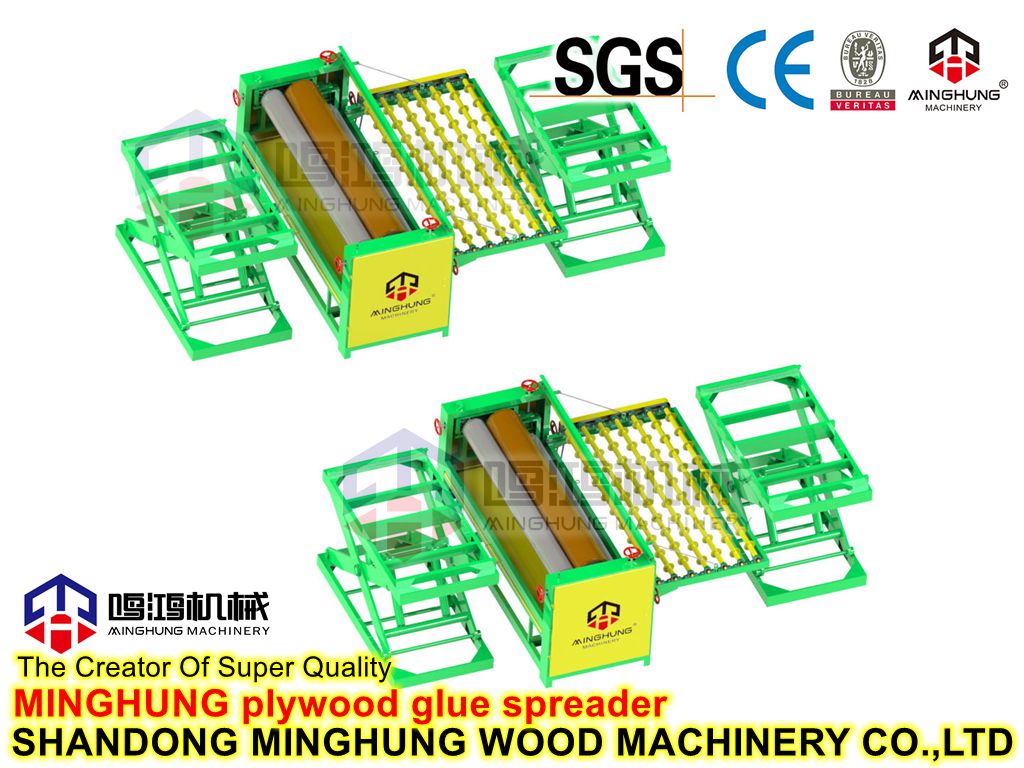
Model: MH-GSM8
Roller length: 2700mm
Roller diameter:410mm
Power: 7.5kw
Weight: 7.5kw
Weight: 3500kg
Size: 3250*1250*1700mm
Use black rubber roll, good material
With the conveyor roll
2. The pre-press equipment is selected in the calculation:
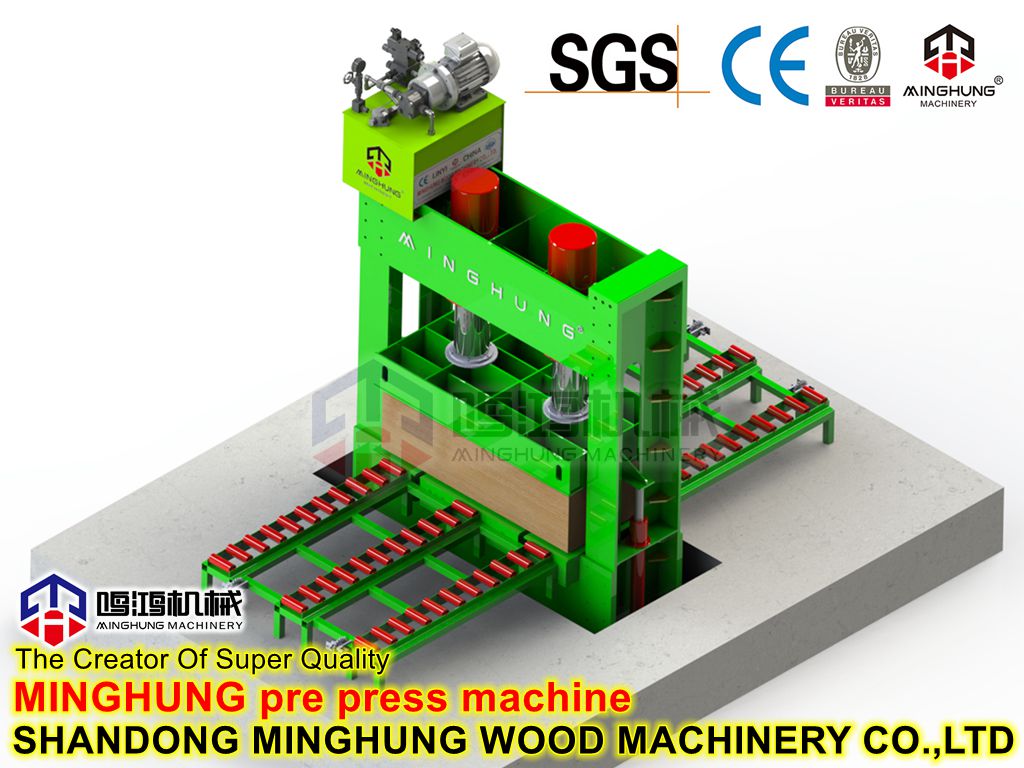
Then the 6-layer plywood Q1=(0.96×480×100×3×1.27×2.49)/(1000×70) =6.24 m³/shift
11-layer plywood Q1=(0.96×480×100×11×1.27×2.49)/(1000×70)=23.52 m³/shift
n=Q total/(Q1×0.7+Q2×0.3)=29.46/(6.24×0.6+23.52×0.4)=2.24 sets
Load percentage η=2.24/3=74.7%
Choose 3 sets of C-400 pre-pressing machines, the technical parameters are as follows:
Total pressure: 420t; Allowable pressure on the working table: 12kg/cm²;
The maximum distance between the working table: 1300mm; Dimensions: 2580×1360mm;
Motor power: 10kw;
The productivity Q (m³/shift) of the pre-press is: Q=K×T×n×s×F/(1000×F total)
In the formula: T------working time per shift (min);
K ------ the working time utilization coefficient of the pre-pressing machine, take 0.96;
n-------The number of sheets of plywood slabs in one pressing, take 100 sheets;
s-------plywood thickness (three layers 3mm, eleven layers 11mm);
F ------ edge-aligned plywood format;
F------In a working cycle, the sum of the time consumed by each factor,Take 70min;
MINGHUNG 500ton Cold press machine
Model: MH-CP
Pressure: 500ton
Cylinder: φ360*2pcs
Length*width: 2700*1370mm
Upper beam thickness: 900mm
Bottom beam thickness: 900mm
Middle beam thickness: 400mm
Max opening: 1800mm
Min opening: 800mm
Motor brand: Siemens
Electric parts: Schneider
Weight: 13ton
Size: 3600*1370*4000mm
3.
Hot press machine/sıcak pres makinesi
Model: MH-HP15
Pressure: 500ton
Cylinder: φ360*2pcs
Floors: 15(16pcs hot plates)
L*W of hot plates: 2700*1370*42mm
Upper beam thickness: 900mm
Bottom beam thickness: 900mm
Middle beam thickness: 400mm
Frame steel thickness: 35mm
Plates distance: 70mm
Power: 29.5kw
Motor brand: Siemens
PLC brand: Siemens
CNC screen: Siemens
Electric parts: Schneider
Size: 3600*1370*5000mm
Weight: 38ton
3.Selection and calculation of plywood trimming equipment:
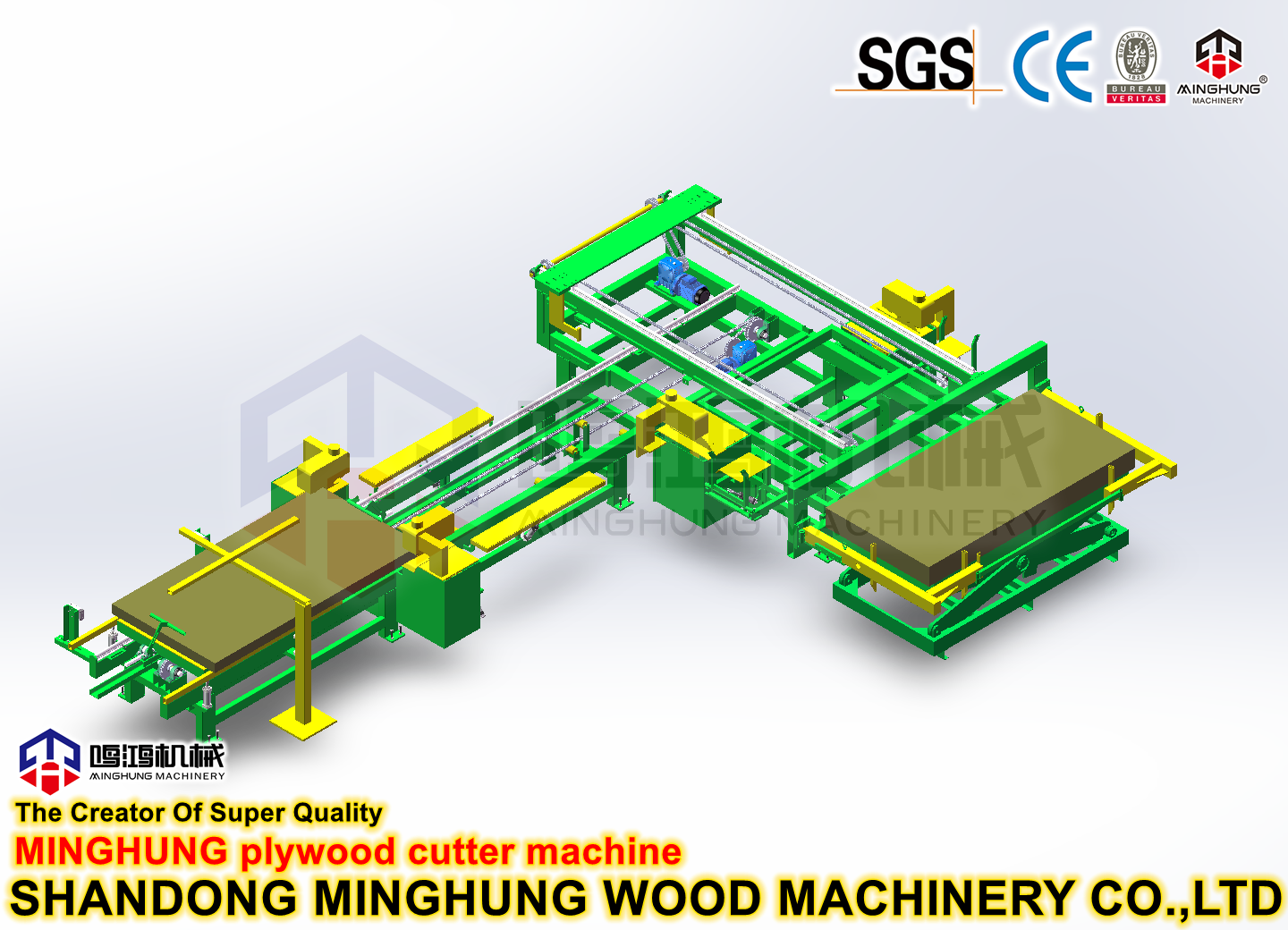
Selection and calculation of double saw blade edge sawing machine:
Productivity A (sheet/shift) is: A=z×K1×K2×n/(2×L)
In the formula: z ----- working time per shift (min)
v-----approaching material speed (m/min), take the average planting of vertical and horizontal feeding speed;
K1--working time utilization coefficient, take 0.91;
K2 - maneuvering time utilization coefficient, take 0.85;
n----the number of sheets of each plywood;
L----the length L (m) of the cut plywood, take the average length and width;
Choose MINGHUNG MH-DD edge sawing machine, the main technical parameters are as follows:
Maximum processing width: vertical 900-1530mm; horizontal 1550-2550mm;
Processing maximum thickness: 38mm;
Feeding speed: longitudinal: 9m/min; transverse: 8m/min;
Dimensions: 9255×7340mm;
Then A=450×8.5×0.91×0.85×4/[2×(2.51/2+1.27/2)]=3147.18 sheets/class
In actual production, the number of sheets of plywood produced per hour is required to be n=266 sheets/h
The number of units needed is n=266×8/3147.18=0.6762 units, take 1 unit,
Load percentage η=0.6762/1×100%=67.6%
MINGHUNG Plywood saw machine
Model: MH-DD
Length: 8feet
Width: 4feet
Working speed: 40-70m/min
Saw blade size: 305mm
Capacity: 4-6pcs/min
Working style: infrared guide
With one set lift table for stacking
Size: 9000*6000*1300mm
Weight: 6ton
4. Selection and calculation of sanding machine equipment:
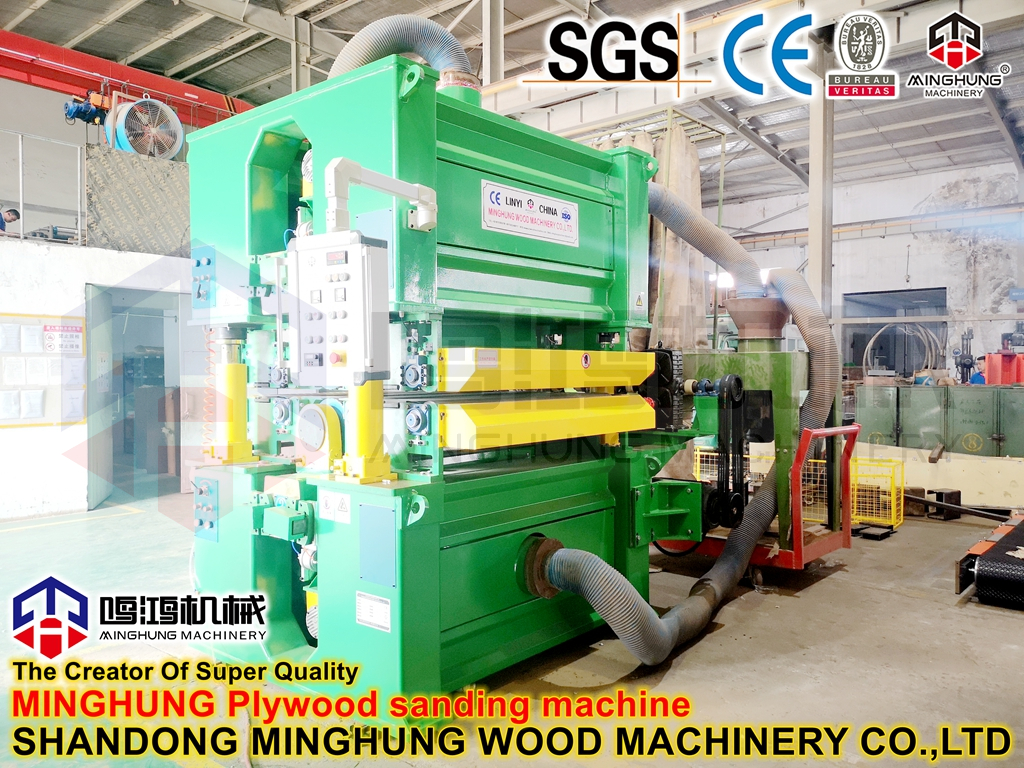
Productivity of double-sided sander (sheets/shift)
A=z×v×K1×K2/(2×L)
In the formula: z ----- machine tool working time (min);
Calculation process and description
v-----feed speed 16m/min,;
K1-----enrichment coefficient of the machine tool, take 0.9
K2-----Working time utilization coefficient, take 0.96;
L ------ The plywood of the feed sander is 15° from the grinding angle
Choose MINGHUNG MH-SD1213 model sander, the technical parameters are as follows:
Working width: 1830mm; Working thickness: 3-20mm;
Abrasive belt quantity: 2 pieces; Abrasive belt length: 2.6m; Feeding speed: 25m/s;
Dimensions: 3200×3700×2800mm;
Then A=(480×16×0.9×0.96)/(2×1.1784)=2815.48 sheets/class
The number of units needed is n=266x8/2815.48=0.7559 units, take 1 unit
Load percentage η=0.7559/1×100%=75.6%
More about plywood making processing contact us:
Whatsapp: +8618769900191 +8615589105786 +8615805493072
Website: www.plywoodmachineline.com
Email: minghungmachinery@gmail.com







